Annotated Bibliography: Neuroscience in Early Childhood Education
VerifiedAdded on 2021/02/21
|14
|3036
|128
Annotated Bibliography
AI Summary
This annotated bibliography provides an overview of three articles related to the neuroscience of children. The first article explores the 'classroom as community' approach, examining how it supports young children's well-being by creating a safe environment and fostering social-emotional development. The second article focuses on art-based interventions to improve children's executive functions, highlighting teachers' strategies to engage students and enhance their cognitive skills through play-based programs. The third article discusses Bloom's taxonomy and its application in assessing and organizing learning objectives for preschoolers, emphasizing the importance of questioning techniques to promote higher-order thinking skills. The bibliography also includes a summative assessment that explores the implications of these articles for early childhood education, emphasizing the roles of teachers and parents in supporting children's development and addressing stress and trauma.

Title Annotated Bibliography
Paraphrase This Document
Need a fresh take? Get an instant paraphrase of this document with our AI Paraphraser
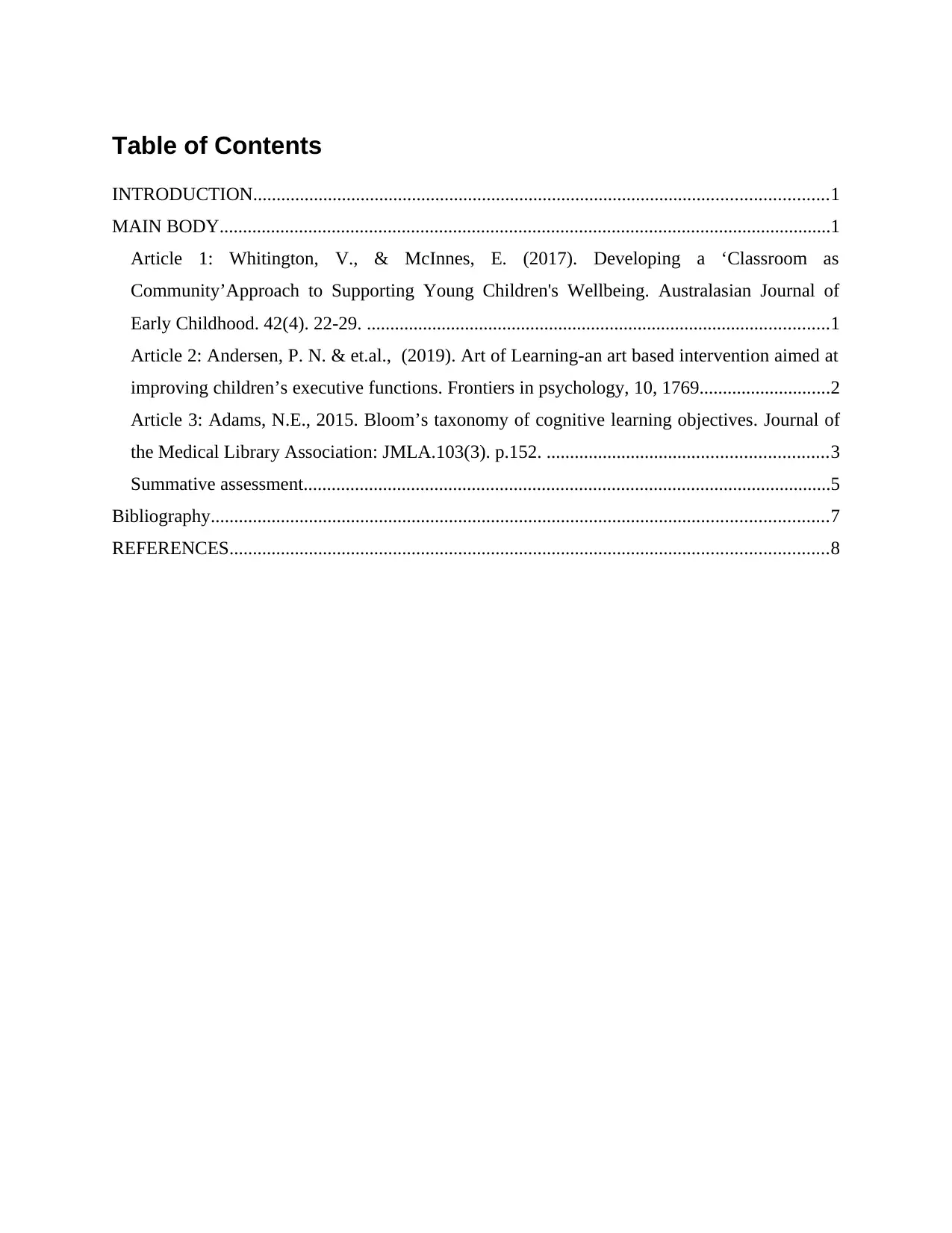
Table of Contents
INTRODUCTION...........................................................................................................................1
MAIN BODY...................................................................................................................................1
Article 1: Whitington, V., & McInnes, E. (2017). Developing a ‘Classroom as
Community’Approach to Supporting Young Children's Wellbeing. Australasian Journal of
Early Childhood. 42(4). 22-29. ...................................................................................................1
Article 2: Andersen, P. N. & et.al., (2019). Art of Learning-an art based intervention aimed at
improving children’s executive functions. Frontiers in psychology, 10, 1769............................2
Article 3: Adams, N.E., 2015. Bloom’s taxonomy of cognitive learning objectives. Journal of
the Medical Library Association: JMLA.103(3). p.152. ............................................................3
Summative assessment.................................................................................................................5
Bibliography....................................................................................................................................7
REFERENCES................................................................................................................................8
INTRODUCTION...........................................................................................................................1
MAIN BODY...................................................................................................................................1
Article 1: Whitington, V., & McInnes, E. (2017). Developing a ‘Classroom as
Community’Approach to Supporting Young Children's Wellbeing. Australasian Journal of
Early Childhood. 42(4). 22-29. ...................................................................................................1
Article 2: Andersen, P. N. & et.al., (2019). Art of Learning-an art based intervention aimed at
improving children’s executive functions. Frontiers in psychology, 10, 1769............................2
Article 3: Adams, N.E., 2015. Bloom’s taxonomy of cognitive learning objectives. Journal of
the Medical Library Association: JMLA.103(3). p.152. ............................................................3
Summative assessment.................................................................................................................5
Bibliography....................................................................................................................................7
REFERENCES................................................................................................................................8
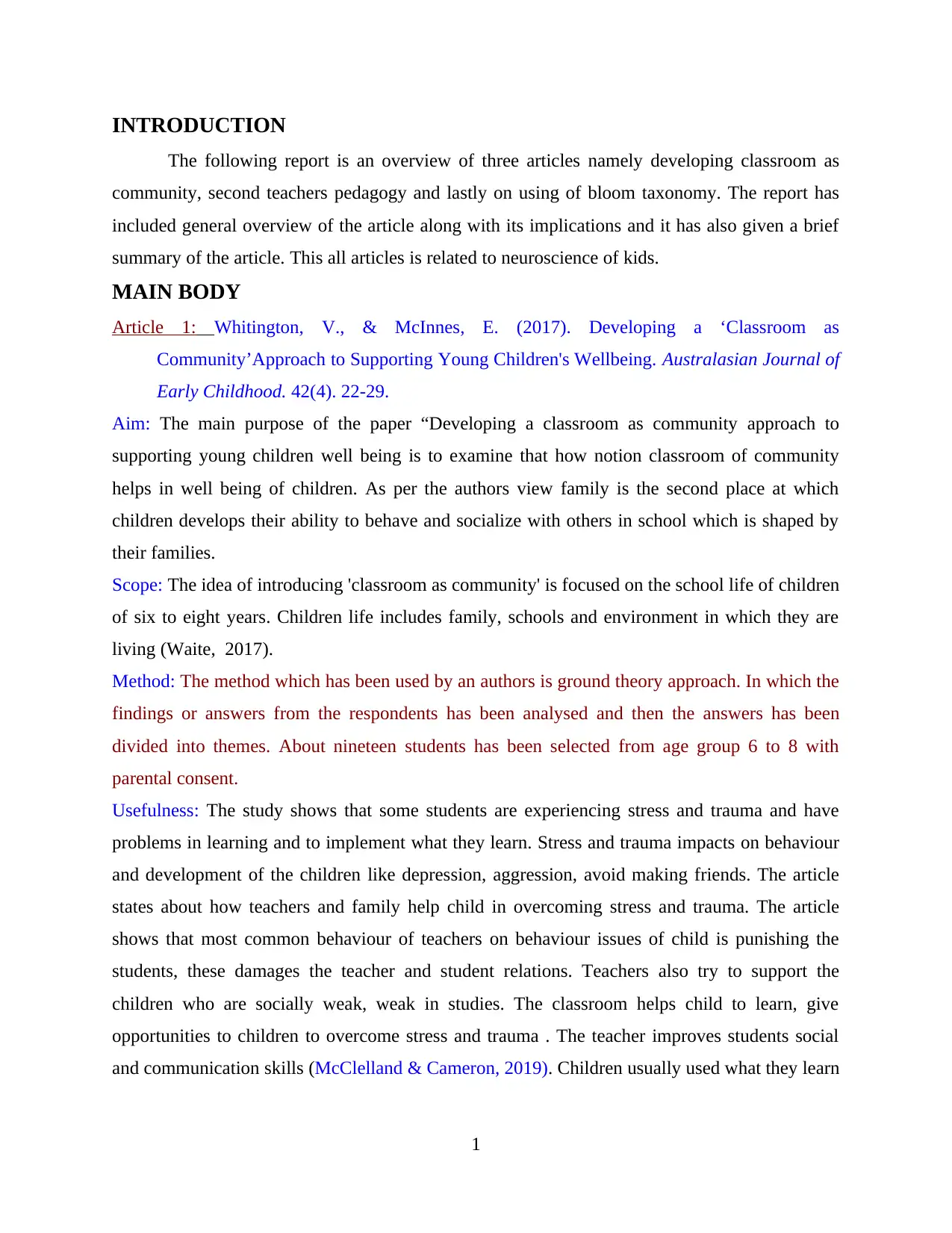
INTRODUCTION
The following report is an overview of three articles namely developing classroom as
community, second teachers pedagogy and lastly on using of bloom taxonomy. The report has
included general overview of the article along with its implications and it has also given a brief
summary of the article. This all articles is related to neuroscience of kids.
MAIN BODY
Article 1: Whitington, V., & McInnes, E. (2017). Developing a ‘Classroom as
Community’Approach to Supporting Young Children's Wellbeing. Australasian Journal of
Early Childhood. 42(4). 22-29.
Aim: The main purpose of the paper “Developing a classroom as community approach to
supporting young children well being is to examine that how notion classroom of community
helps in well being of children. As per the authors view family is the second place at which
children develops their ability to behave and socialize with others in school which is shaped by
their families.
Scope: The idea of introducing 'classroom as community' is focused on the school life of children
of six to eight years. Children life includes family, schools and environment in which they are
living (Waite, 2017).
Method: The method which has been used by an authors is ground theory approach. In which the
findings or answers from the respondents has been analysed and then the answers has been
divided into themes. About nineteen students has been selected from age group 6 to 8 with
parental consent.
Usefulness: The study shows that some students are experiencing stress and trauma and have
problems in learning and to implement what they learn. Stress and trauma impacts on behaviour
and development of the children like depression, aggression, avoid making friends. The article
states about how teachers and family help child in overcoming stress and trauma. The article
shows that most common behaviour of teachers on behaviour issues of child is punishing the
students, these damages the teacher and student relations. Teachers also try to support the
children who are socially weak, weak in studies. The classroom helps child to learn, give
opportunities to children to overcome stress and trauma . The teacher improves students social
and communication skills (McClelland & Cameron, 2019). Children usually used what they learn
1
The following report is an overview of three articles namely developing classroom as
community, second teachers pedagogy and lastly on using of bloom taxonomy. The report has
included general overview of the article along with its implications and it has also given a brief
summary of the article. This all articles is related to neuroscience of kids.
MAIN BODY
Article 1: Whitington, V., & McInnes, E. (2017). Developing a ‘Classroom as
Community’Approach to Supporting Young Children's Wellbeing. Australasian Journal of
Early Childhood. 42(4). 22-29.
Aim: The main purpose of the paper “Developing a classroom as community approach to
supporting young children well being is to examine that how notion classroom of community
helps in well being of children. As per the authors view family is the second place at which
children develops their ability to behave and socialize with others in school which is shaped by
their families.
Scope: The idea of introducing 'classroom as community' is focused on the school life of children
of six to eight years. Children life includes family, schools and environment in which they are
living (Waite, 2017).
Method: The method which has been used by an authors is ground theory approach. In which the
findings or answers from the respondents has been analysed and then the answers has been
divided into themes. About nineteen students has been selected from age group 6 to 8 with
parental consent.
Usefulness: The study shows that some students are experiencing stress and trauma and have
problems in learning and to implement what they learn. Stress and trauma impacts on behaviour
and development of the children like depression, aggression, avoid making friends. The article
states about how teachers and family help child in overcoming stress and trauma. The article
shows that most common behaviour of teachers on behaviour issues of child is punishing the
students, these damages the teacher and student relations. Teachers also try to support the
children who are socially weak, weak in studies. The classroom helps child to learn, give
opportunities to children to overcome stress and trauma . The teacher improves students social
and communication skills (McClelland & Cameron, 2019). Children usually used what they learn
1
⊘ This is a preview!⊘
Do you want full access?
Subscribe today to unlock all pages.

Trusted by 1+ million students worldwide
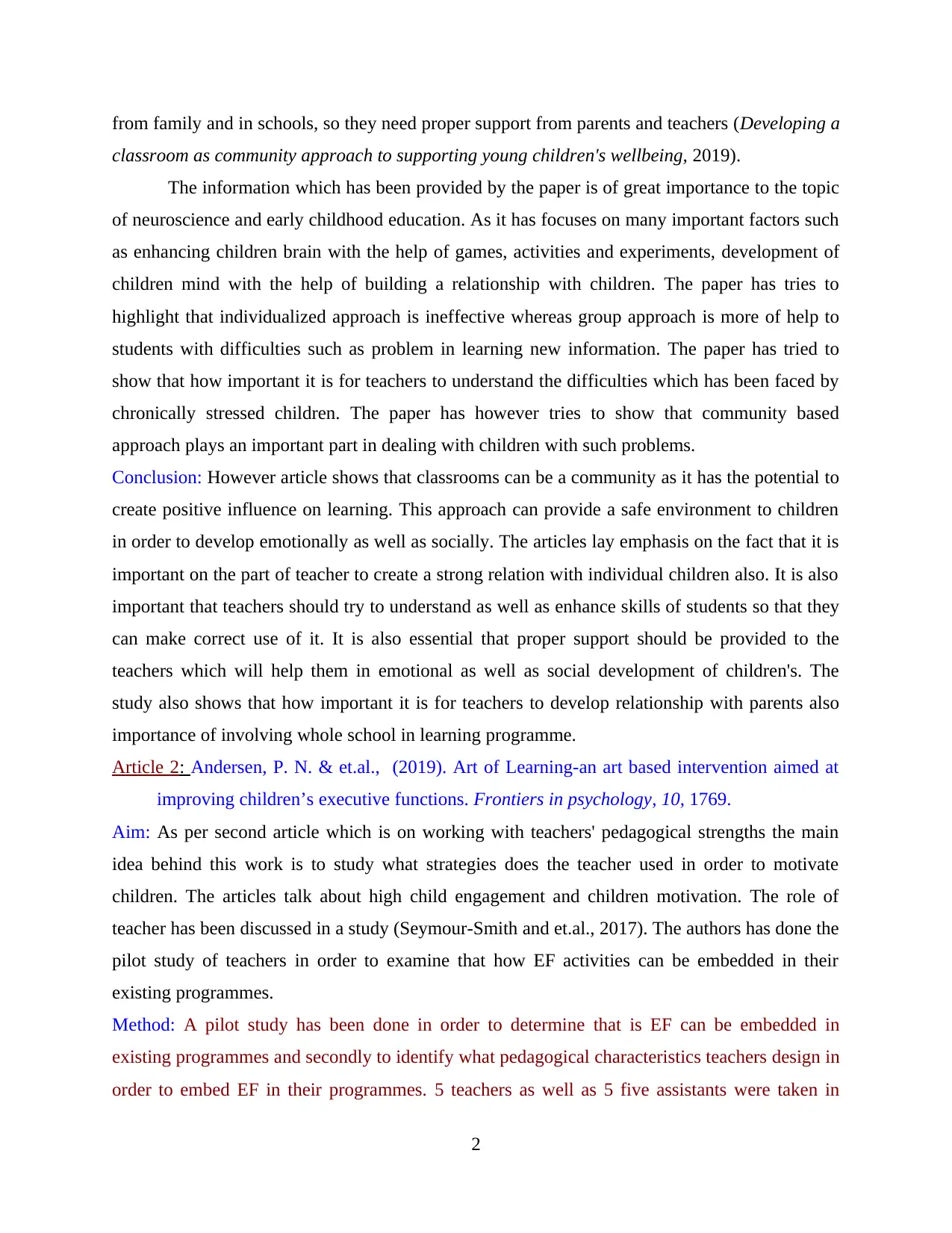
from family and in schools, so they need proper support from parents and teachers (Developing a
classroom as community approach to supporting young children's wellbeing, 2019).
The information which has been provided by the paper is of great importance to the topic
of neuroscience and early childhood education. As it has focuses on many important factors such
as enhancing children brain with the help of games, activities and experiments, development of
children mind with the help of building a relationship with children. The paper has tries to
highlight that individualized approach is ineffective whereas group approach is more of help to
students with difficulties such as problem in learning new information. The paper has tried to
show that how important it is for teachers to understand the difficulties which has been faced by
chronically stressed children. The paper has however tries to show that community based
approach plays an important part in dealing with children with such problems.
Conclusion: However article shows that classrooms can be a community as it has the potential to
create positive influence on learning. This approach can provide a safe environment to children
in order to develop emotionally as well as socially. The articles lay emphasis on the fact that it is
important on the part of teacher to create a strong relation with individual children also. It is also
important that teachers should try to understand as well as enhance skills of students so that they
can make correct use of it. It is also essential that proper support should be provided to the
teachers which will help them in emotional as well as social development of children's. The
study also shows that how important it is for teachers to develop relationship with parents also
importance of involving whole school in learning programme.
Article 2: Andersen, P. N. & et.al., (2019). Art of Learning-an art based intervention aimed at
improving children’s executive functions. Frontiers in psychology, 10, 1769.
Aim: As per second article which is on working with teachers' pedagogical strengths the main
idea behind this work is to study what strategies does the teacher used in order to motivate
children. The articles talk about high child engagement and children motivation. The role of
teacher has been discussed in a study (Seymour-Smith and et.al., 2017). The authors has done the
pilot study of teachers in order to examine that how EF activities can be embedded in their
existing programmes.
Method: A pilot study has been done in order to determine that is EF can be embedded in
existing programmes and secondly to identify what pedagogical characteristics teachers design in
order to embed EF in their programmes. 5 teachers as well as 5 five assistants were taken in
2
classroom as community approach to supporting young children's wellbeing, 2019).
The information which has been provided by the paper is of great importance to the topic
of neuroscience and early childhood education. As it has focuses on many important factors such
as enhancing children brain with the help of games, activities and experiments, development of
children mind with the help of building a relationship with children. The paper has tries to
highlight that individualized approach is ineffective whereas group approach is more of help to
students with difficulties such as problem in learning new information. The paper has tried to
show that how important it is for teachers to understand the difficulties which has been faced by
chronically stressed children. The paper has however tries to show that community based
approach plays an important part in dealing with children with such problems.
Conclusion: However article shows that classrooms can be a community as it has the potential to
create positive influence on learning. This approach can provide a safe environment to children
in order to develop emotionally as well as socially. The articles lay emphasis on the fact that it is
important on the part of teacher to create a strong relation with individual children also. It is also
important that teachers should try to understand as well as enhance skills of students so that they
can make correct use of it. It is also essential that proper support should be provided to the
teachers which will help them in emotional as well as social development of children's. The
study also shows that how important it is for teachers to develop relationship with parents also
importance of involving whole school in learning programme.
Article 2: Andersen, P. N. & et.al., (2019). Art of Learning-an art based intervention aimed at
improving children’s executive functions. Frontiers in psychology, 10, 1769.
Aim: As per second article which is on working with teachers' pedagogical strengths the main
idea behind this work is to study what strategies does the teacher used in order to motivate
children. The articles talk about high child engagement and children motivation. The role of
teacher has been discussed in a study (Seymour-Smith and et.al., 2017). The authors has done the
pilot study of teachers in order to examine that how EF activities can be embedded in their
existing programmes.
Method: A pilot study has been done in order to determine that is EF can be embedded in
existing programmes and secondly to identify what pedagogical characteristics teachers design in
order to embed EF in their programmes. 5 teachers as well as 5 five assistants were taken in
2
Paraphrase This Document
Need a fresh take? Get an instant paraphrase of this document with our AI Paraphraser
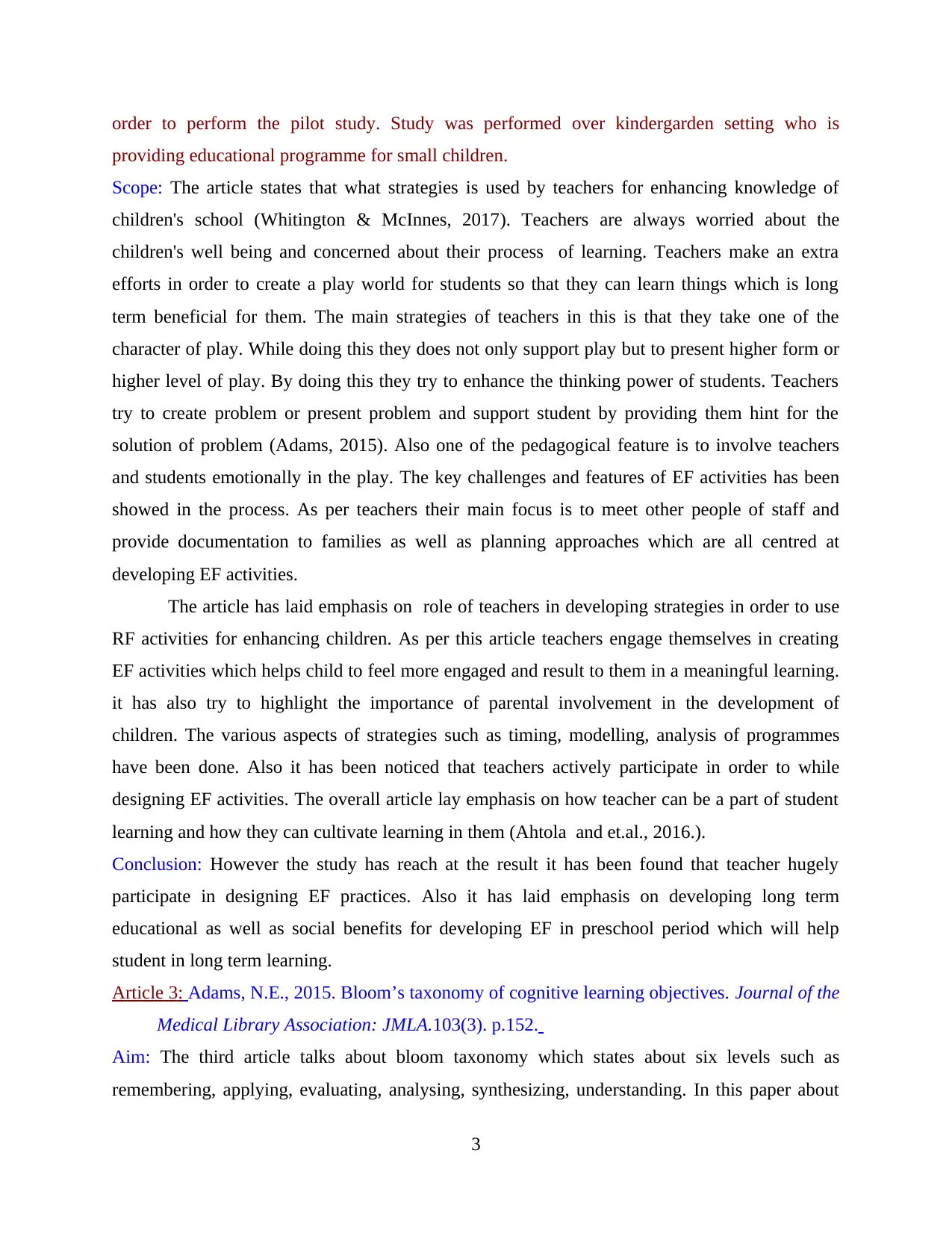
order to perform the pilot study. Study was performed over kindergarden setting who is
providing educational programme for small children.
Scope: The article states that what strategies is used by teachers for enhancing knowledge of
children's school (Whitington & McInnes, 2017). Teachers are always worried about the
children's well being and concerned about their process of learning. Teachers make an extra
efforts in order to create a play world for students so that they can learn things which is long
term beneficial for them. The main strategies of teachers in this is that they take one of the
character of play. While doing this they does not only support play but to present higher form or
higher level of play. By doing this they try to enhance the thinking power of students. Teachers
try to create problem or present problem and support student by providing them hint for the
solution of problem (Adams, 2015). Also one of the pedagogical feature is to involve teachers
and students emotionally in the play. The key challenges and features of EF activities has been
showed in the process. As per teachers their main focus is to meet other people of staff and
provide documentation to families as well as planning approaches which are all centred at
developing EF activities.
The article has laid emphasis on role of teachers in developing strategies in order to use
RF activities for enhancing children. As per this article teachers engage themselves in creating
EF activities which helps child to feel more engaged and result to them in a meaningful learning.
it has also try to highlight the importance of parental involvement in the development of
children. The various aspects of strategies such as timing, modelling, analysis of programmes
have been done. Also it has been noticed that teachers actively participate in order to while
designing EF activities. The overall article lay emphasis on how teacher can be a part of student
learning and how they can cultivate learning in them (Ahtola and et.al., 2016.).
Conclusion: However the study has reach at the result it has been found that teacher hugely
participate in designing EF practices. Also it has laid emphasis on developing long term
educational as well as social benefits for developing EF in preschool period which will help
student in long term learning.
Article 3: Adams, N.E., 2015. Bloom’s taxonomy of cognitive learning objectives. Journal of the
Medical Library Association: JMLA.103(3). p.152.
Aim: The third article talks about bloom taxonomy which states about six levels such as
remembering, applying, evaluating, analysing, synthesizing, understanding. In this paper about
3
providing educational programme for small children.
Scope: The article states that what strategies is used by teachers for enhancing knowledge of
children's school (Whitington & McInnes, 2017). Teachers are always worried about the
children's well being and concerned about their process of learning. Teachers make an extra
efforts in order to create a play world for students so that they can learn things which is long
term beneficial for them. The main strategies of teachers in this is that they take one of the
character of play. While doing this they does not only support play but to present higher form or
higher level of play. By doing this they try to enhance the thinking power of students. Teachers
try to create problem or present problem and support student by providing them hint for the
solution of problem (Adams, 2015). Also one of the pedagogical feature is to involve teachers
and students emotionally in the play. The key challenges and features of EF activities has been
showed in the process. As per teachers their main focus is to meet other people of staff and
provide documentation to families as well as planning approaches which are all centred at
developing EF activities.
The article has laid emphasis on role of teachers in developing strategies in order to use
RF activities for enhancing children. As per this article teachers engage themselves in creating
EF activities which helps child to feel more engaged and result to them in a meaningful learning.
it has also try to highlight the importance of parental involvement in the development of
children. The various aspects of strategies such as timing, modelling, analysis of programmes
have been done. Also it has been noticed that teachers actively participate in order to while
designing EF activities. The overall article lay emphasis on how teacher can be a part of student
learning and how they can cultivate learning in them (Ahtola and et.al., 2016.).
Conclusion: However the study has reach at the result it has been found that teacher hugely
participate in designing EF practices. Also it has laid emphasis on developing long term
educational as well as social benefits for developing EF in preschool period which will help
student in long term learning.
Article 3: Adams, N.E., 2015. Bloom’s taxonomy of cognitive learning objectives. Journal of the
Medical Library Association: JMLA.103(3). p.152.
Aim: The third article talks about bloom taxonomy which states about six levels such as
remembering, applying, evaluating, analysing, synthesizing, understanding. In this paper about
3
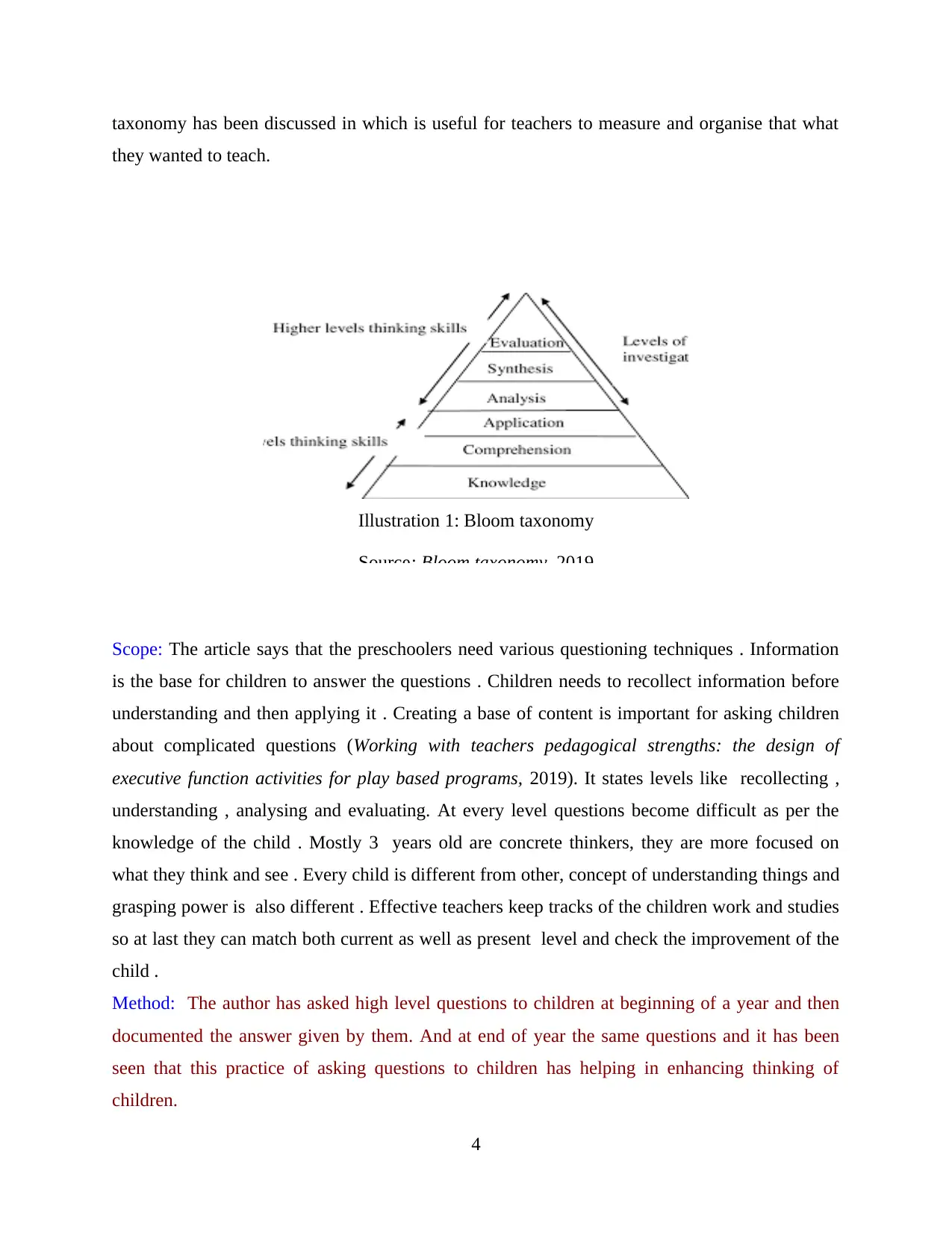
taxonomy has been discussed in which is useful for teachers to measure and organise that what
they wanted to teach.
Scope: The article says that the preschoolers need various questioning techniques . Information
is the base for children to answer the questions . Children needs to recollect information before
understanding and then applying it . Creating a base of content is important for asking children
about complicated questions (Working with teachers pedagogical strengths: the design of
executive function activities for play based programs, 2019). It states levels like recollecting ,
understanding , analysing and evaluating. At every level questions become difficult as per the
knowledge of the child . Mostly 3 years old are concrete thinkers, they are more focused on
what they think and see . Every child is different from other, concept of understanding things and
grasping power is also different . Effective teachers keep tracks of the children work and studies
so at last they can match both current as well as present level and check the improvement of the
child .
Method: The author has asked high level questions to children at beginning of a year and then
documented the answer given by them. And at end of year the same questions and it has been
seen that this practice of asking questions to children has helping in enhancing thinking of
children.
4
Illustration 1: Bloom taxonomy
Source: Bloom taxonomy, 2019
they wanted to teach.
Scope: The article says that the preschoolers need various questioning techniques . Information
is the base for children to answer the questions . Children needs to recollect information before
understanding and then applying it . Creating a base of content is important for asking children
about complicated questions (Working with teachers pedagogical strengths: the design of
executive function activities for play based programs, 2019). It states levels like recollecting ,
understanding , analysing and evaluating. At every level questions become difficult as per the
knowledge of the child . Mostly 3 years old are concrete thinkers, they are more focused on
what they think and see . Every child is different from other, concept of understanding things and
grasping power is also different . Effective teachers keep tracks of the children work and studies
so at last they can match both current as well as present level and check the improvement of the
child .
Method: The author has asked high level questions to children at beginning of a year and then
documented the answer given by them. And at end of year the same questions and it has been
seen that this practice of asking questions to children has helping in enhancing thinking of
children.
4
Illustration 1: Bloom taxonomy
Source: Bloom taxonomy, 2019
⊘ This is a preview!⊘
Do you want full access?
Subscribe today to unlock all pages.

Trusted by 1+ million students worldwide
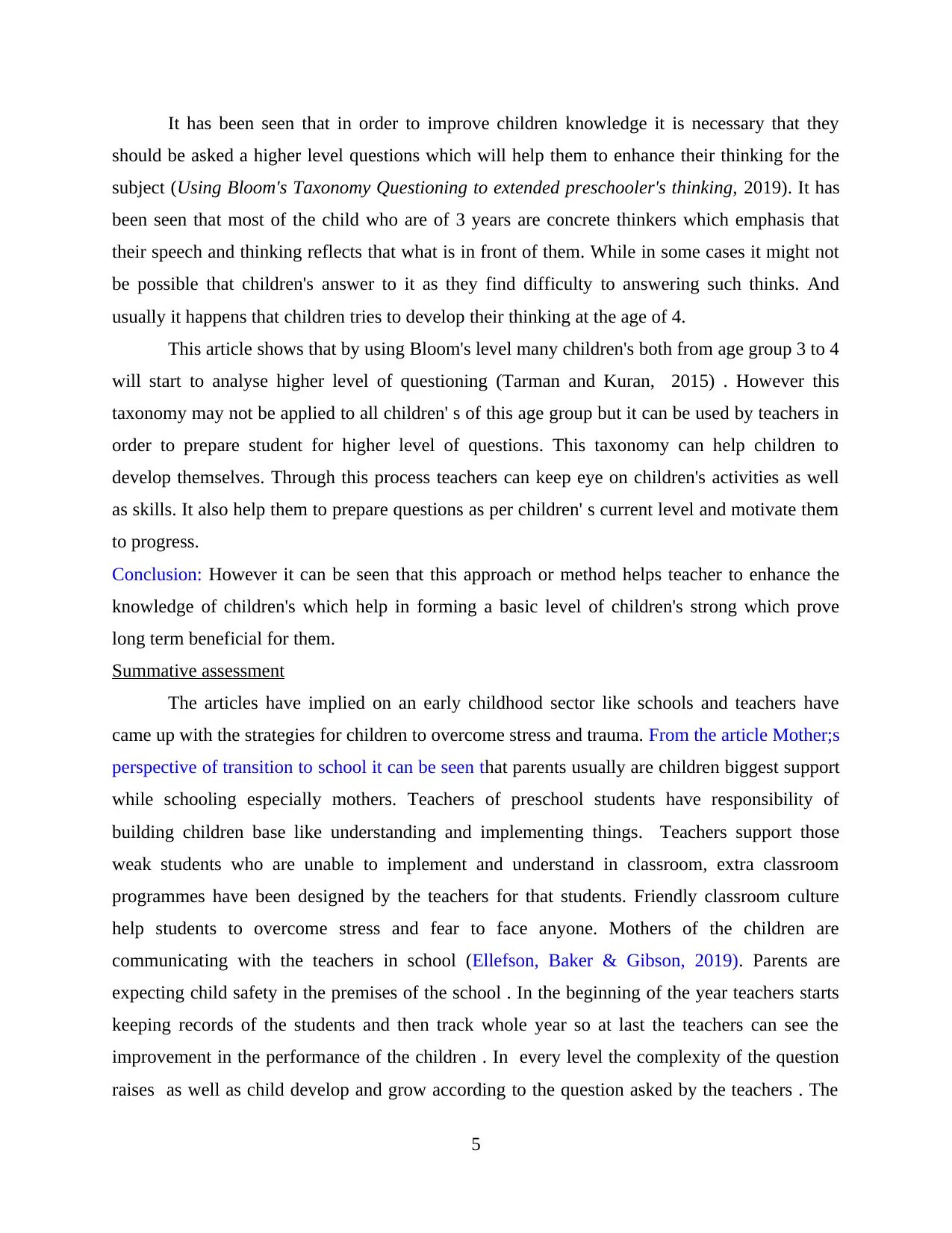
It has been seen that in order to improve children knowledge it is necessary that they
should be asked a higher level questions which will help them to enhance their thinking for the
subject (Using Bloom's Taxonomy Questioning to extended preschooler's thinking, 2019). It has
been seen that most of the child who are of 3 years are concrete thinkers which emphasis that
their speech and thinking reflects that what is in front of them. While in some cases it might not
be possible that children's answer to it as they find difficulty to answering such thinks. And
usually it happens that children tries to develop their thinking at the age of 4.
This article shows that by using Bloom's level many children's both from age group 3 to 4
will start to analyse higher level of questioning (Tarman and Kuran, 2015) . However this
taxonomy may not be applied to all children' s of this age group but it can be used by teachers in
order to prepare student for higher level of questions. This taxonomy can help children to
develop themselves. Through this process teachers can keep eye on children's activities as well
as skills. It also help them to prepare questions as per children' s current level and motivate them
to progress.
Conclusion: However it can be seen that this approach or method helps teacher to enhance the
knowledge of children's which help in forming a basic level of children's strong which prove
long term beneficial for them.
Summative assessment
The articles have implied on an early childhood sector like schools and teachers have
came up with the strategies for children to overcome stress and trauma. From the article Mother;s
perspective of transition to school it can be seen that parents usually are children biggest support
while schooling especially mothers. Teachers of preschool students have responsibility of
building children base like understanding and implementing things. Teachers support those
weak students who are unable to implement and understand in classroom, extra classroom
programmes have been designed by the teachers for that students. Friendly classroom culture
help students to overcome stress and fear to face anyone. Mothers of the children are
communicating with the teachers in school (Ellefson, Baker & Gibson, 2019). Parents are
expecting child safety in the premises of the school . In the beginning of the year teachers starts
keeping records of the students and then track whole year so at last the teachers can see the
improvement in the performance of the children . In every level the complexity of the question
raises as well as child develop and grow according to the question asked by the teachers . The
5
should be asked a higher level questions which will help them to enhance their thinking for the
subject (Using Bloom's Taxonomy Questioning to extended preschooler's thinking, 2019). It has
been seen that most of the child who are of 3 years are concrete thinkers which emphasis that
their speech and thinking reflects that what is in front of them. While in some cases it might not
be possible that children's answer to it as they find difficulty to answering such thinks. And
usually it happens that children tries to develop their thinking at the age of 4.
This article shows that by using Bloom's level many children's both from age group 3 to 4
will start to analyse higher level of questioning (Tarman and Kuran, 2015) . However this
taxonomy may not be applied to all children' s of this age group but it can be used by teachers in
order to prepare student for higher level of questions. This taxonomy can help children to
develop themselves. Through this process teachers can keep eye on children's activities as well
as skills. It also help them to prepare questions as per children' s current level and motivate them
to progress.
Conclusion: However it can be seen that this approach or method helps teacher to enhance the
knowledge of children's which help in forming a basic level of children's strong which prove
long term beneficial for them.
Summative assessment
The articles have implied on an early childhood sector like schools and teachers have
came up with the strategies for children to overcome stress and trauma. From the article Mother;s
perspective of transition to school it can be seen that parents usually are children biggest support
while schooling especially mothers. Teachers of preschool students have responsibility of
building children base like understanding and implementing things. Teachers support those
weak students who are unable to implement and understand in classroom, extra classroom
programmes have been designed by the teachers for that students. Friendly classroom culture
help students to overcome stress and fear to face anyone. Mothers of the children are
communicating with the teachers in school (Ellefson, Baker & Gibson, 2019). Parents are
expecting child safety in the premises of the school . In the beginning of the year teachers starts
keeping records of the students and then track whole year so at last the teachers can see the
improvement in the performance of the children . In every level the complexity of the question
raises as well as child develop and grow according to the question asked by the teachers . The
5
Paraphrase This Document
Need a fresh take? Get an instant paraphrase of this document with our AI Paraphraser
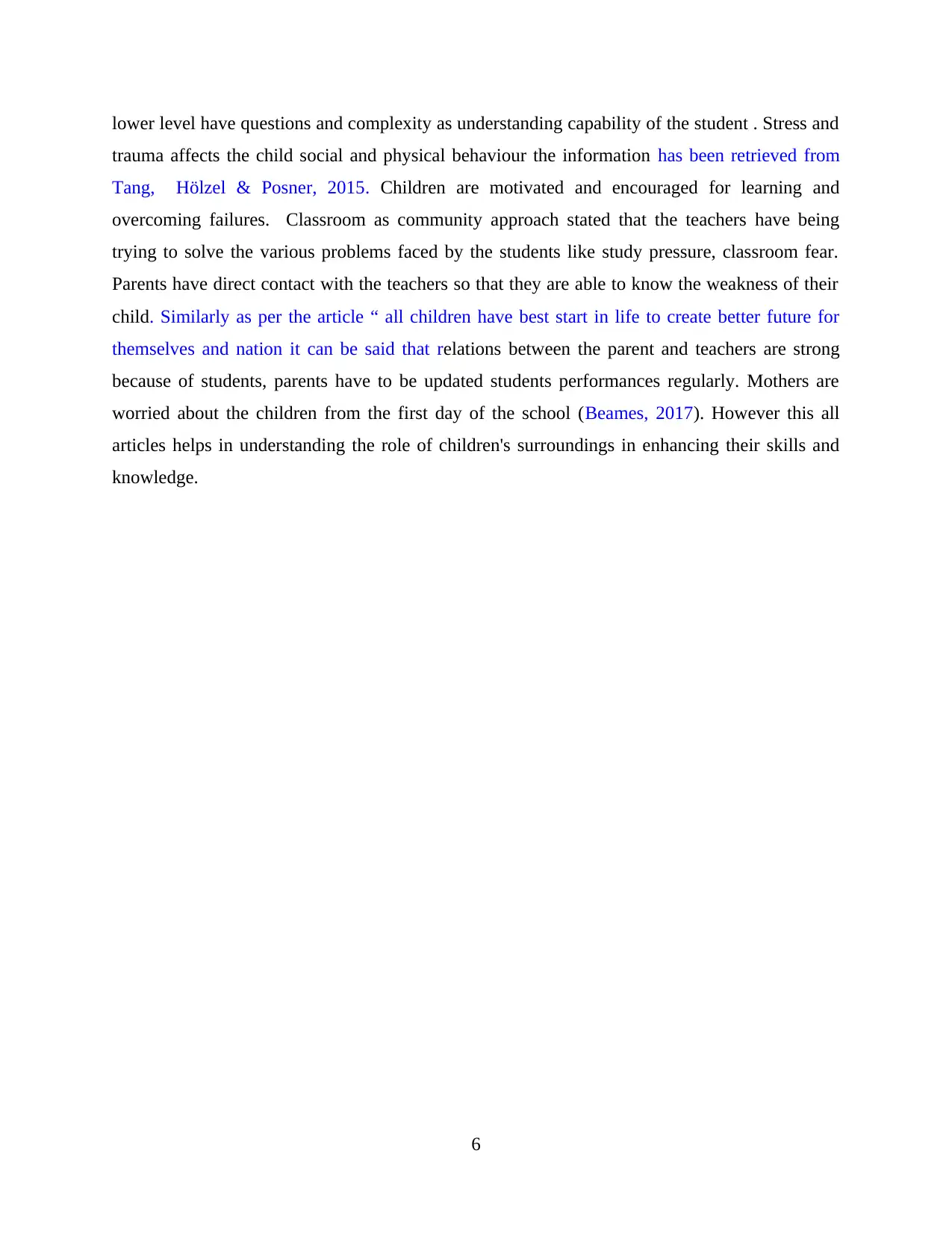
lower level have questions and complexity as understanding capability of the student . Stress and
trauma affects the child social and physical behaviour the information has been retrieved from
Tang, Hölzel & Posner, 2015. Children are motivated and encouraged for learning and
overcoming failures. Classroom as community approach stated that the teachers have being
trying to solve the various problems faced by the students like study pressure, classroom fear.
Parents have direct contact with the teachers so that they are able to know the weakness of their
child. Similarly as per the article “ all children have best start in life to create better future for
themselves and nation it can be said that relations between the parent and teachers are strong
because of students, parents have to be updated students performances regularly. Mothers are
worried about the children from the first day of the school (Beames, 2017). However this all
articles helps in understanding the role of children's surroundings in enhancing their skills and
knowledge.
6
trauma affects the child social and physical behaviour the information has been retrieved from
Tang, Hölzel & Posner, 2015. Children are motivated and encouraged for learning and
overcoming failures. Classroom as community approach stated that the teachers have being
trying to solve the various problems faced by the students like study pressure, classroom fear.
Parents have direct contact with the teachers so that they are able to know the weakness of their
child. Similarly as per the article “ all children have best start in life to create better future for
themselves and nation it can be said that relations between the parent and teachers are strong
because of students, parents have to be updated students performances regularly. Mothers are
worried about the children from the first day of the school (Beames, 2017). However this all
articles helps in understanding the role of children's surroundings in enhancing their skills and
knowledge.
6

Bibliography
https://www.researchgate.net/figure/Benjamin-Blooms-Taxonomy-of-Critical-
Thinking_fig1_326803979
https://journals.sagepub.com/doi/abs/10.23965/AJEC.42.4.06
https://journals.sagepub.com/doi/abs/10.23965/AJEC.42.4.03
7
https://www.researchgate.net/figure/Benjamin-Blooms-Taxonomy-of-Critical-
Thinking_fig1_326803979
https://journals.sagepub.com/doi/abs/10.23965/AJEC.42.4.06
https://journals.sagepub.com/doi/abs/10.23965/AJEC.42.4.03
7
⊘ This is a preview!⊘
Do you want full access?
Subscribe today to unlock all pages.

Trusted by 1+ million students worldwide
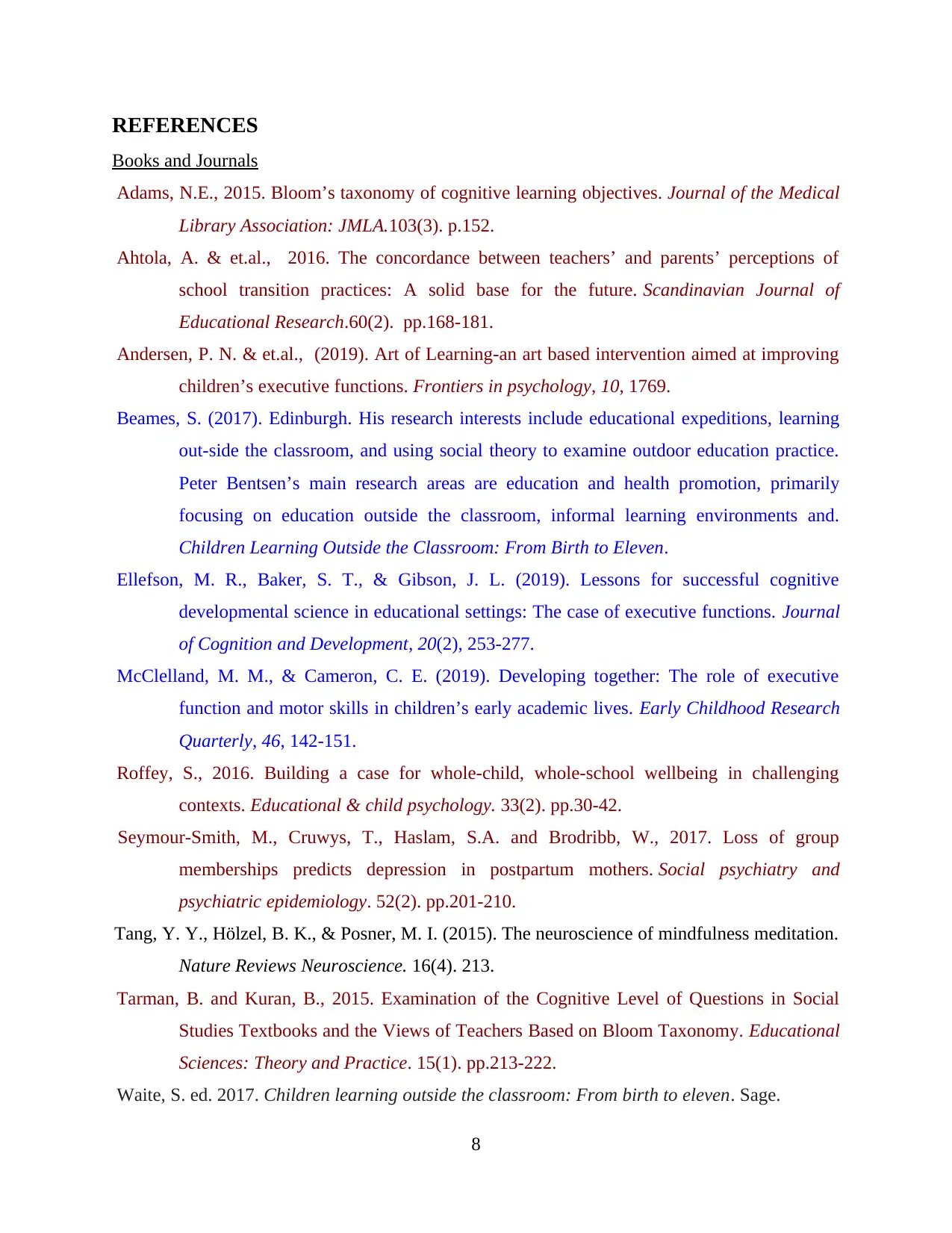
REFERENCES
Books and Journals
Adams, N.E., 2015. Bloom’s taxonomy of cognitive learning objectives. Journal of the Medical
Library Association: JMLA.103(3). p.152.
Ahtola, A. & et.al., 2016. The concordance between teachers’ and parents’ perceptions of
school transition practices: A solid base for the future. Scandinavian Journal of
Educational Research.60(2). pp.168-181.
Andersen, P. N. & et.al., (2019). Art of Learning-an art based intervention aimed at improving
children’s executive functions. Frontiers in psychology, 10, 1769.
Beames, S. (2017). Edinburgh. His research interests include educational expeditions, learning
out-side the classroom, and using social theory to examine outdoor education practice.
Peter Bentsen’s main research areas are education and health promotion, primarily
focusing on education outside the classroom, informal learning environments and.
Children Learning Outside the Classroom: From Birth to Eleven.
Ellefson, M. R., Baker, S. T., & Gibson, J. L. (2019). Lessons for successful cognitive
developmental science in educational settings: The case of executive functions. Journal
of Cognition and Development, 20(2), 253-277.
McClelland, M. M., & Cameron, C. E. (2019). Developing together: The role of executive
function and motor skills in children’s early academic lives. Early Childhood Research
Quarterly, 46, 142-151.
Roffey, S., 2016. Building a case for whole-child, whole-school wellbeing in challenging
contexts. Educational & child psychology. 33(2). pp.30-42.
Seymour-Smith, M., Cruwys, T., Haslam, S.A. and Brodribb, W., 2017. Loss of group
memberships predicts depression in postpartum mothers. Social psychiatry and
psychiatric epidemiology. 52(2). pp.201-210.
Tang, Y. Y., Hölzel, B. K., & Posner, M. I. (2015). The neuroscience of mindfulness meditation.
Nature Reviews Neuroscience. 16(4). 213.
Tarman, B. and Kuran, B., 2015. Examination of the Cognitive Level of Questions in Social
Studies Textbooks and the Views of Teachers Based on Bloom Taxonomy. Educational
Sciences: Theory and Practice. 15(1). pp.213-222.
Waite, S. ed. 2017. Children learning outside the classroom: From birth to eleven. Sage.
8
Books and Journals
Adams, N.E., 2015. Bloom’s taxonomy of cognitive learning objectives. Journal of the Medical
Library Association: JMLA.103(3). p.152.
Ahtola, A. & et.al., 2016. The concordance between teachers’ and parents’ perceptions of
school transition practices: A solid base for the future. Scandinavian Journal of
Educational Research.60(2). pp.168-181.
Andersen, P. N. & et.al., (2019). Art of Learning-an art based intervention aimed at improving
children’s executive functions. Frontiers in psychology, 10, 1769.
Beames, S. (2017). Edinburgh. His research interests include educational expeditions, learning
out-side the classroom, and using social theory to examine outdoor education practice.
Peter Bentsen’s main research areas are education and health promotion, primarily
focusing on education outside the classroom, informal learning environments and.
Children Learning Outside the Classroom: From Birth to Eleven.
Ellefson, M. R., Baker, S. T., & Gibson, J. L. (2019). Lessons for successful cognitive
developmental science in educational settings: The case of executive functions. Journal
of Cognition and Development, 20(2), 253-277.
McClelland, M. M., & Cameron, C. E. (2019). Developing together: The role of executive
function and motor skills in children’s early academic lives. Early Childhood Research
Quarterly, 46, 142-151.
Roffey, S., 2016. Building a case for whole-child, whole-school wellbeing in challenging
contexts. Educational & child psychology. 33(2). pp.30-42.
Seymour-Smith, M., Cruwys, T., Haslam, S.A. and Brodribb, W., 2017. Loss of group
memberships predicts depression in postpartum mothers. Social psychiatry and
psychiatric epidemiology. 52(2). pp.201-210.
Tang, Y. Y., Hölzel, B. K., & Posner, M. I. (2015). The neuroscience of mindfulness meditation.
Nature Reviews Neuroscience. 16(4). 213.
Tarman, B. and Kuran, B., 2015. Examination of the Cognitive Level of Questions in Social
Studies Textbooks and the Views of Teachers Based on Bloom Taxonomy. Educational
Sciences: Theory and Practice. 15(1). pp.213-222.
Waite, S. ed. 2017. Children learning outside the classroom: From birth to eleven. Sage.
8
Paraphrase This Document
Need a fresh take? Get an instant paraphrase of this document with our AI Paraphraser
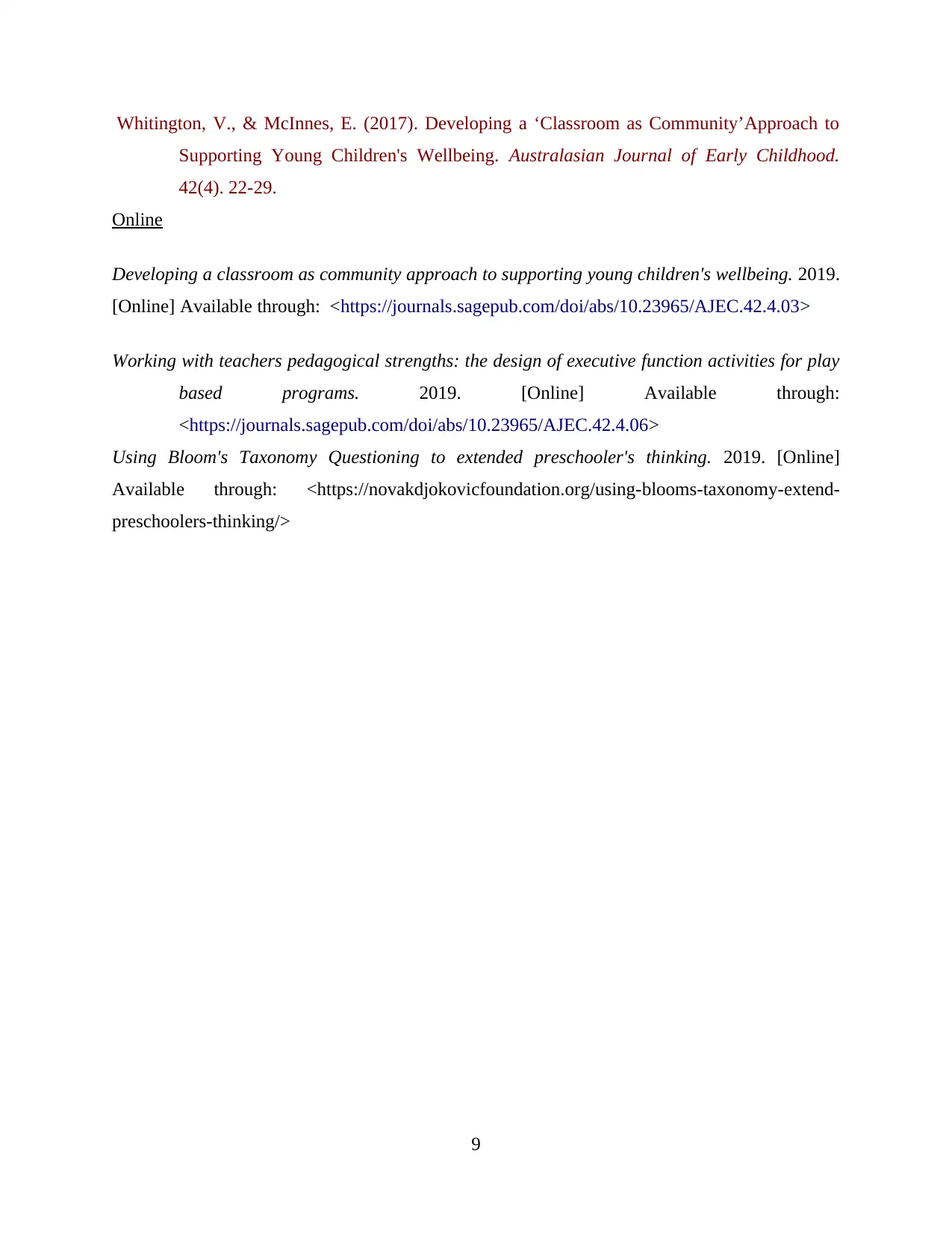
Whitington, V., & McInnes, E. (2017). Developing a ‘Classroom as Community’Approach to
Supporting Young Children's Wellbeing. Australasian Journal of Early Childhood.
42(4). 22-29.
Online
Developing a classroom as community approach to supporting young children's wellbeing. 2019.
[Online] Available through: <https://journals.sagepub.com/doi/abs/10.23965/AJEC.42.4.03>
Working with teachers pedagogical strengths: the design of executive function activities for play
based programs. 2019. [Online] Available through:
<https://journals.sagepub.com/doi/abs/10.23965/AJEC.42.4.06>
Using Bloom's Taxonomy Questioning to extended preschooler's thinking. 2019. [Online]
Available through: <https://novakdjokovicfoundation.org/using-blooms-taxonomy-extend-
preschoolers-thinking/>
9
Supporting Young Children's Wellbeing. Australasian Journal of Early Childhood.
42(4). 22-29.
Online
Developing a classroom as community approach to supporting young children's wellbeing. 2019.
[Online] Available through: <https://journals.sagepub.com/doi/abs/10.23965/AJEC.42.4.03>
Working with teachers pedagogical strengths: the design of executive function activities for play
based programs. 2019. [Online] Available through:
<https://journals.sagepub.com/doi/abs/10.23965/AJEC.42.4.06>
Using Bloom's Taxonomy Questioning to extended preschooler's thinking. 2019. [Online]
Available through: <https://novakdjokovicfoundation.org/using-blooms-taxonomy-extend-
preschoolers-thinking/>
9

10
⊘ This is a preview!⊘
Do you want full access?
Subscribe today to unlock all pages.

Trusted by 1+ million students worldwide
1 out of 14
Related Documents
Your All-in-One AI-Powered Toolkit for Academic Success.
+13062052269
info@desklib.com
Available 24*7 on WhatsApp / Email
![[object Object]](/_next/static/media/star-bottom.7253800d.svg)
Unlock your academic potential
Copyright © 2020–2025 A2Z Services. All Rights Reserved. Developed and managed by ZUCOL.





